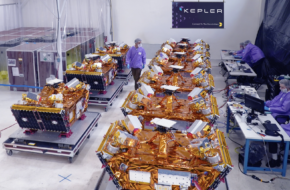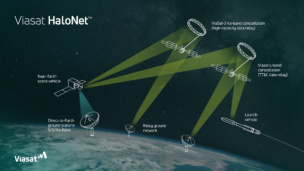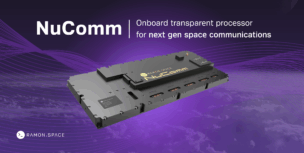Our Commercial Heritage Can Be Leveraged for National Security Missions
Maxar Space Systems is a leader in providing comprehensive space technologies for over 65 years. We are a trusted partner in commercial and government sectors with a suite of solutions that span satellite communications, electro-optical systems for Earth observation and missile defense, and space exploration.
Our customers depend on us to deliver reliable systems at an affordable price. Most of our contracts are based on fixed price terms with well defined requirements because we have spent time with our customers to understand how we can meet their mission needs. This type of collaboration has resulted in mission success with 98 Maxar 1300 ™ geostationary satellites currently in service and 6, first-of-a-kind, Maxar 500 ™ spacecraft operating on orbit.
Today, the United States finds itself operating in a high-threat and fast-moving environment. However, it can feel at times like our national security acquisition system is stuck in slow gear. While there is much conversation about speed, adaptability and scale, we continue to ask our defense and intelligence partners to deliver transformative capabilities through outdated processes.
We believe it is time to reimagine the procurement process on a fundamental level, and the U.S. government has echoed similar sentiments. Recently, the U.S. government has emphasized the need to “buy commercial where we can and build bespoke where we must.” President Trump’s April 2025 directive reinforced this, requiring agencies to prioritize cost-effective commercial solutions in federal contracts.
The next step is action. And we believe our playbook could serve as a model for the proven efficiency, discipline and agility of the commercial space sector.
Commercial Satellite Procurement Knows How to Move Fast
At Maxar Space Systems, we have launched over three hundred satellites for global commercial clients. Our customers, from telecommunications firms to Earth observation providers, buy from us efficiently. How?
- They engage early with industry, with sufficient time to receive feedback from the industry before releasing a Request for Proposal (RFP).
- They establish clear and stable requirements before contract award. They then strive to hold to those requirements throughout the life of the contract.
- They use fixed-price contracts, with upfront milestone payments aligned to supply chain realities.
- They send empowered personnel on-site to resolve issues in real-time, not by briefing charts, but by walking the factory floor.
These practices are not theoretical. They are in use today and they work. We are ready to implement these practices in the procurement process with the U.S government as soon as they are.
What’s Holding Us Back?
Despite congressional encouragement and direction (such as the FY2019 NDAA commercial item definition reform), the government still struggles with limited interpretations of “commercial product” and overly rigid acquisition templates. The result is that companies with proven track records of mature, exquisite capabilities are often boxed out or forced to reshape their offerings into something that fits a legacy contracting model, rather than something that is ready for immediate warfighter support.
Too often, market research consists of asking industry to complete surveys, not visiting suppliers, reviewing actual flight heritage or digging into financial viability. As a result, the system favors familiarity over performance, and process over outcomes. We believe this is not a productive or sustainable model, and we want to be part of the change.
We Have Solutions: What the Government Can Do Right Now
To continue strengthening aerospace procurement practices, the government should prioritize several key actions:
- Expand “Commercial Product” Definition
Treat commercially derived space systems as commercial, even if they require minor modification for use in national security settings. For example, use the definition of “commercial product” aggressively, including what is characterized as a minor modification, to expand FAR Part 12-based acquisition of commercially derived space systems. - Engage Early, Engage Often, and Engage In-Person
Do not wait for an industry day. Visit the factory. Talk to engineers. Ask lots of questions. Understand what is flight-proven and what is not. This type of engagement will help understanding of how existing products can meet mission needs. - Fund Pilot Contracts, Not White Papers
Broaden study contracts with non-traditional defense contractors and fund “flat sat” evaluations. We have found structured demos and commercial-first task orders drive more learning than five years of Requests for Information (RFIs). - Broaden the Use of Adaptive Contracts: Encourage the strategic use of tailored contracting approaches that align with program complexity, maturity and risk.
- Train the Acquisition Workforce to Run Fixed Price at Speed
Admittedly, we understand that fixed price is not easy, but it works when clear requirements are established upfront. Equip program managers and contracting officers with modern tools, data and continuation training needed to manage complex, adaptive contracts that are critical for defense projects. Accommodate the upfront effort and the payoff will be faster delivery and reduced cost risk. - Incentivize Commercial Past Performance
Shift perspective to place increased value on a satellite with five plus years of successful commercial service over a slide deck describing an untested government only design.- Build and expand on successful pilot efforts to test innovative approaches and apply lessons learned to broader programs of record.
Maxar Space Systems: Ready to Lead in a New Era of Acquisition
We are not a traditional defense prime. We are a commercial first company with a decades-long record of delivering high quality space systems on orbit, on budget and on time. We do not believe the government must choose between commercial innovation and mission assurance. We believe the two can, and must, coexist. But for that to happen, the system must evolve.
This is not about deregulation. This is not about cutting corners. This is about modernization and unleashing our full potential. Our adversaries are not waiting. Neither should we. The tools, the talent and the technology are already in place. Let’s move together, with speed and resolve.




